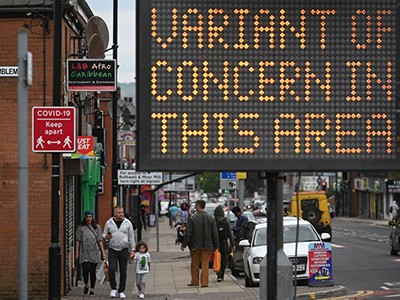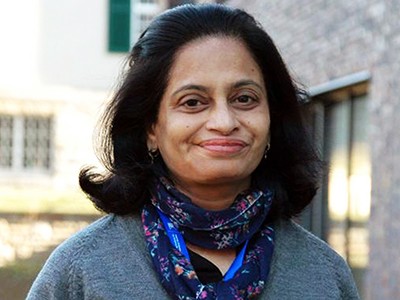As head of one of India’s main genomics laboratories, I am part of the consortium that first reported the B.1.617 strain of SARS-CoV-2 as a potential variant of concern. I keep asking myself how we might have predicted its danger sooner, tracked it rapidly and stalled its spread.
This year, I saw what felt like a year of deaths in a couple of weeks, among my friends, colleagues and family. There were ill people all around, calling for help, oxygen and beds. The health-care challenges were beyond imaginable. I can state with sad confidence that such catastrophic events are unavoidable without preventive measures. With just 5% of the world fully vaccinated, simple public-health interventions — masks, ventilation, quarantines — remain the cornerstone of containment. Limiting transmission gives the virus less chance to mutate.
Yet variants of concern continue to emerge. My colleagues and I are tracking the spread of the sublineage B.1.617.2, determining how effective vaccines are against it and advising on optimal approaches to vaccination. It will not be enough to stop the pandemic.
Strategies for tackling COVID-19 must include new, faster ways to spot and stop the spread of alarming new mutants. This requires: more sharing of data and methods; funding to develop better predictions and simpler tests; and integration of genomics, informatics and public health.
Faster identification means both more sequencing and more-targeted sequencing. The technologies are established. Last July, my institute ran the first assessment of Illumina’s high-throughput COVIDSeq assay, now the default global platform for sequencing SARS-CoV-2 genomes. The assay was used to develop a structured genomic-surveillance service for the Indian state of Kerala. I believe that this contributed to a timely and appropriate public-health response in the state, where there have been fewer deaths than in the rest of India, despite a similar prevalence of B.1.617.2.
The Indian SARS-CoV-2 sequencing consortium (INSACOG) began operations in January, when there were about 15,000 new infections each day in this nation of 1.4 billion people. The original plan was to randomly sequence samples from 5% of all cases. But, like many, we had not anticipated an extreme spike in infections. A 30-fold increase in daily cases, plus the difficulty of shipping samples around a country more than 13 times the size of the United Kingdom, with fewer resources, made this impossible.
Before April, INSACOG managed to sequence around 0.75% of positive cases. Targeted sequencing of an outbreak in Maharashtra identified B.1.617. In a similar way, scientists in South Africa spotted the highly transmissible B.1.351 variant in an outbreak in October 2020, and were able to tip off British scientists about the related B.1.1.7 variant.
India urgently needs to intensify sequencing of unusual outbreaks, reinfections and cases in which vaccinated people become infected, while maintaining ‘sentry sequencing’ of a constant number of representative samples nation-wide. The problem is that variants at low frequency will be missed. Looking back, the first sequences of what turned out to be B.1.617 were available in December 2020, when cases were declining. It was identified as a cause for concern in March (from samples sequenced in February after a January outbreak), on the basis of spiking cases and the presence of mutations seen in other troubling variants.
This three-month identification period is typical for variants of concern, but is much too long. Detecting variants from changes in case loads, hospitalizations or deaths is like driving with an opaque front windscreen and only a dusty rear-view mirror, especially without digital health systems.
I estimate that we can shave three weeks off current timelines by establishing large, high-throughput sequencing hubs, alongside smaller, distributed ‘spokes’ that perform rapid but low-throughput sequencing, and by improving logistics for integrating results from samples with clinical data. All of this will require more funding and, more importantly, deeper engagement with regional health leadership.
We also need to find a way for basic research to flag dangerous mutations, either computationally or experimentally. Past experience with in silico assessments have been discouraging. New artificial-intelligence-based methods for predicting viral structures, such as Google’s AlphaFold, supported by open data — experimental and epidemiological — could forecast the effects of mutations. Until then, simpler predictions and case-based data would mean that new variants could be checked for flagged mutations.
To contain spread, knowing which variants are a concern is not enough. We must find the people carrying them. More is needed to track dangerous variants rapidly. Current tests diagnose whether someone is infected with SARS-CoV-2, not which variant they have.
Ideally, variant detection would happen in parallel with diagnosis, without sending samples to specialized sequencing labs. For that, we must develop simple variant tests that are affordable, easy for health-care workers to run using basic kit, and integrated into the systems that test, isolate and trace contacts. There are some promising new technologies, including low-cost CRISPR diagnostics for places with limited resources. Developing these should be prioritized.
Public-health measures remain paramount, but will be less effective if variants become more transmissible or more deadly, or can evade vaccines. Science must adapt.
"need" - Google News
June 01, 2021 at 06:52PM
https://ift.tt/3i6bUrV
India's COVID crisis flags need to forecast variants - Nature.com
"need" - Google News
https://ift.tt/3c23wne
https://ift.tt/2YsHiXz
Bagikan Berita Ini

















0 Response to "India's COVID crisis flags need to forecast variants - Nature.com"
Post a Comment